International Trade: Openness, Inequality, and Stolper-Samuelson Model
VerifiedAdded on 2023/06/06
|6
|837
|166
Report
AI Summary
This report examines the relationship between international trade openness and industry pay inequality, using data from Singapore and the United States. It explores the correlation between a country's openness, measured by trade as a percentage of GDP, and industry pay inequality, finding a positive correlation in both countries. The report also delves into the Stolper-Samuelson theorem, explaining how changes in output prices affect factor returns, particularly wages for skilled and unskilled labor. By analyzing the export baskets of Singapore and the US, the report provides empirical evidence supporting the Stolper-Samuelson theorem, demonstrating how increased trade openness can lead to higher wages for skilled labor, the abundant factor in both economies. Desklib provides access to similar solved assignments and past papers for students.
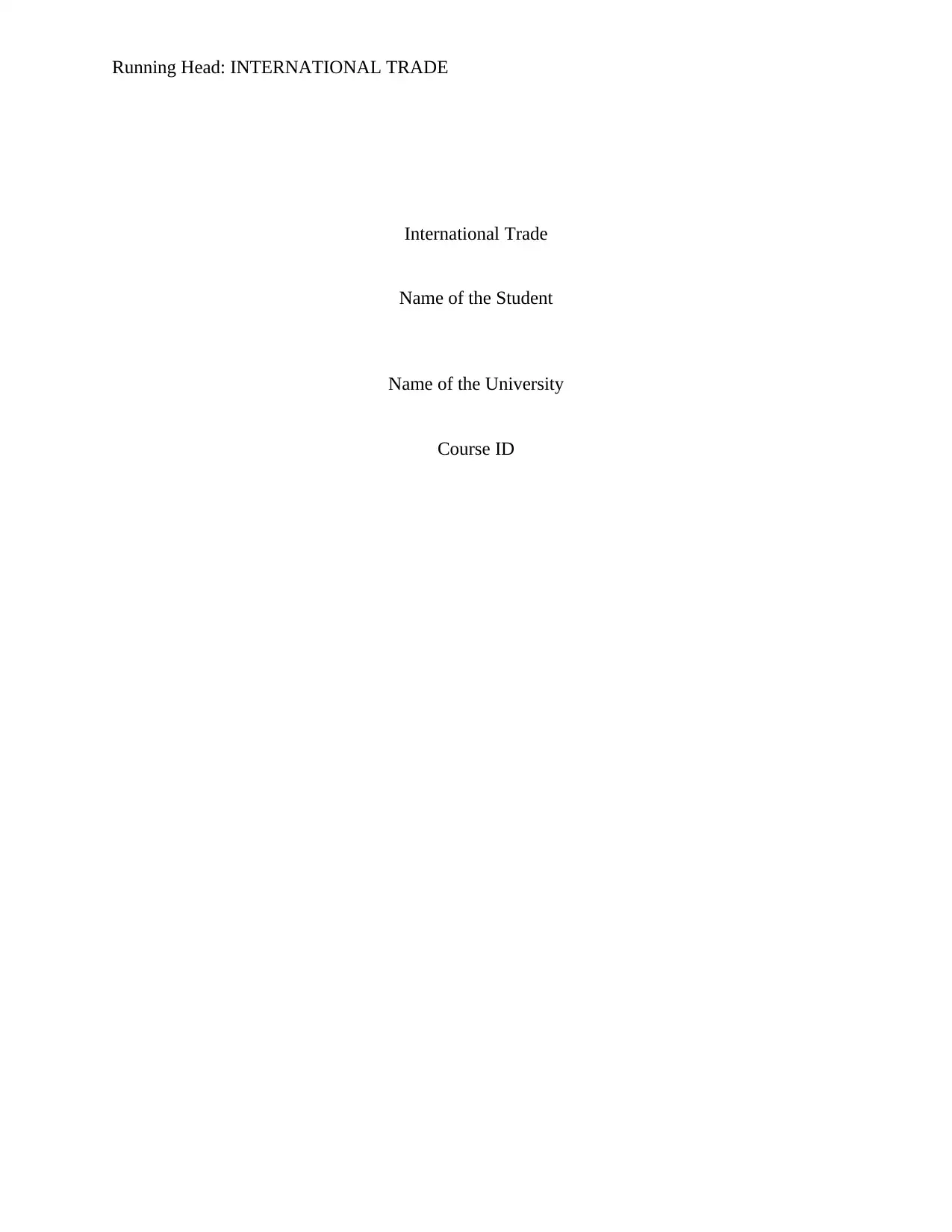
Running Head: INTERNATIONAL TRADE
International Trade
Name of the Student
Name of the University
Course ID
International Trade
Name of the Student
Name of the University
Course ID
Paraphrase This Document
Need a fresh take? Get an instant paraphrase of this document with our AI Paraphraser
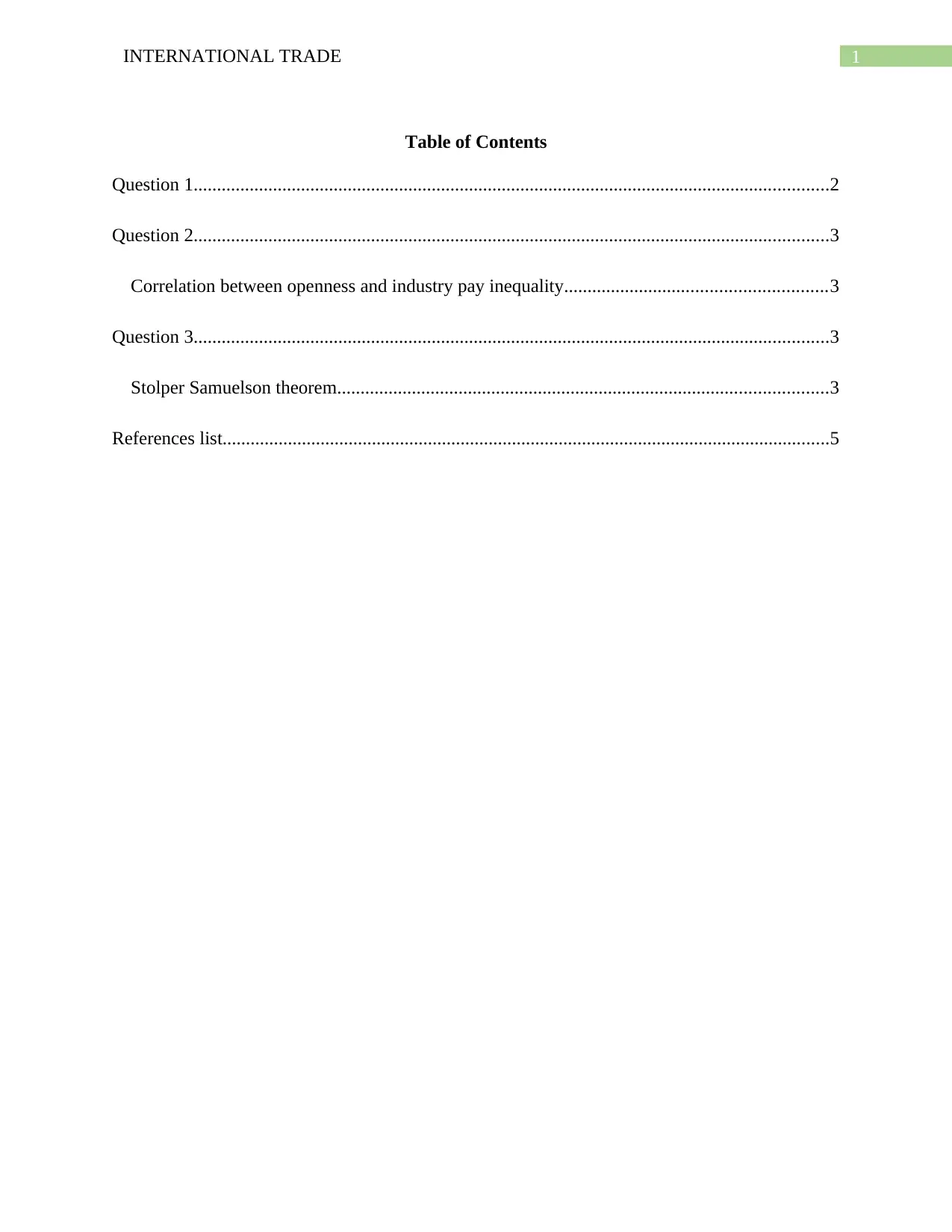
1INTERNATIONAL TRADE
Table of Contents
Question 1........................................................................................................................................2
Question 2........................................................................................................................................3
Correlation between openness and industry pay inequality........................................................3
Question 3........................................................................................................................................3
Stolper Samuelson theorem.........................................................................................................3
References list..................................................................................................................................5
Table of Contents
Question 1........................................................................................................................................2
Question 2........................................................................................................................................3
Correlation between openness and industry pay inequality........................................................3
Question 3........................................................................................................................................3
Stolper Samuelson theorem.........................................................................................................3
References list..................................................................................................................................5
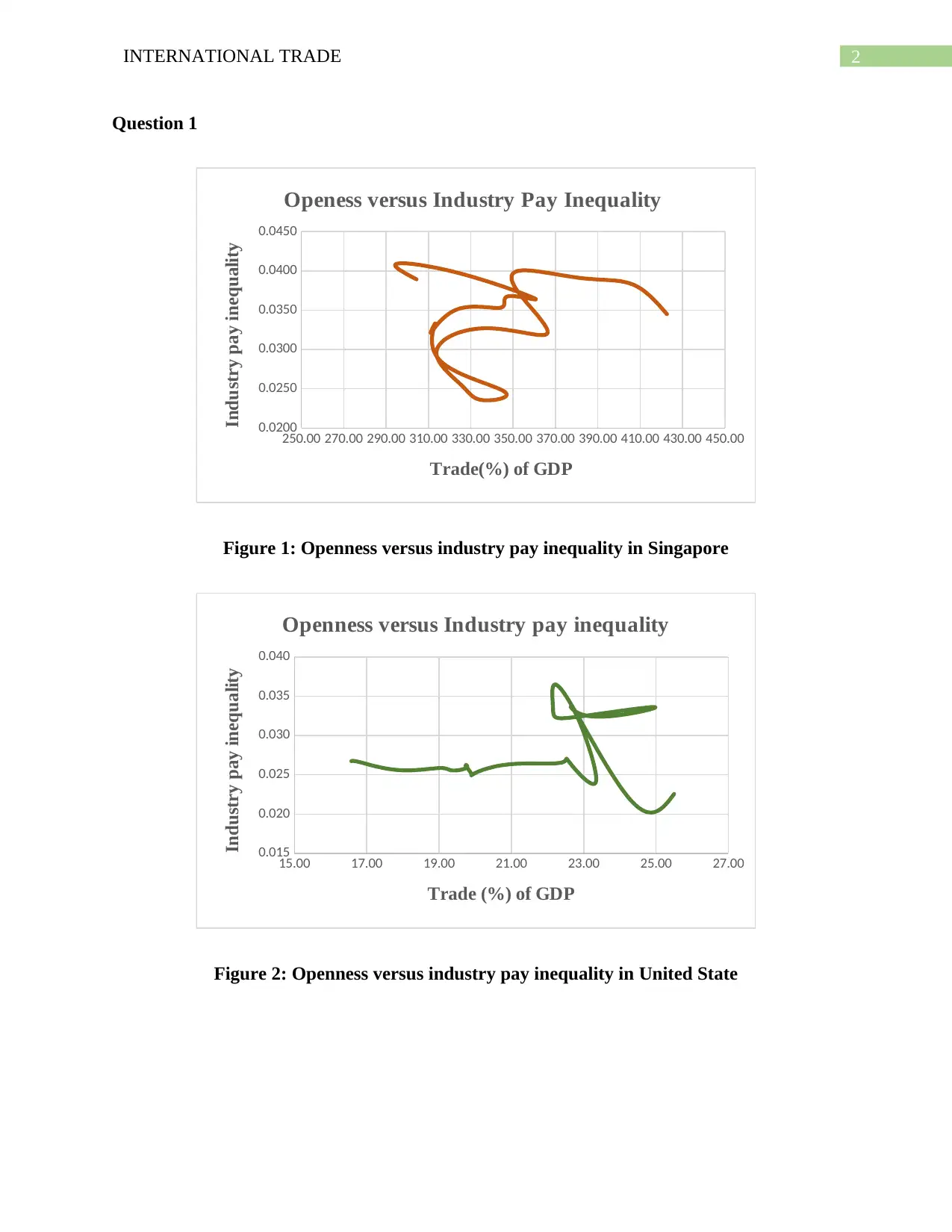
2INTERNATIONAL TRADE
Question 1
250.00 270.00 290.00 310.00 330.00 350.00 370.00 390.00 410.00 430.00 450.00
0.0200
0.0250
0.0300
0.0350
0.0400
0.0450
Openess versus Industry Pay Inequality
Trade(%) of GDP
Industry pay inequality
Figure 1: Openness versus industry pay inequality in Singapore
15.00 17.00 19.00 21.00 23.00 25.00 27.00
0.015
0.020
0.025
0.030
0.035
0.040
Openness versus Industry pay inequality
Trade (%) of GDP
Industry pay inequality
Figure 2: Openness versus industry pay inequality in United State
Question 1
250.00 270.00 290.00 310.00 330.00 350.00 370.00 390.00 410.00 430.00 450.00
0.0200
0.0250
0.0300
0.0350
0.0400
0.0450
Openess versus Industry Pay Inequality
Trade(%) of GDP
Industry pay inequality
Figure 1: Openness versus industry pay inequality in Singapore
15.00 17.00 19.00 21.00 23.00 25.00 27.00
0.015
0.020
0.025
0.030
0.035
0.040
Openness versus Industry pay inequality
Trade (%) of GDP
Industry pay inequality
Figure 2: Openness versus industry pay inequality in United State
⊘ This is a preview!⊘
Do you want full access?
Subscribe today to unlock all pages.

Trusted by 1+ million students worldwide
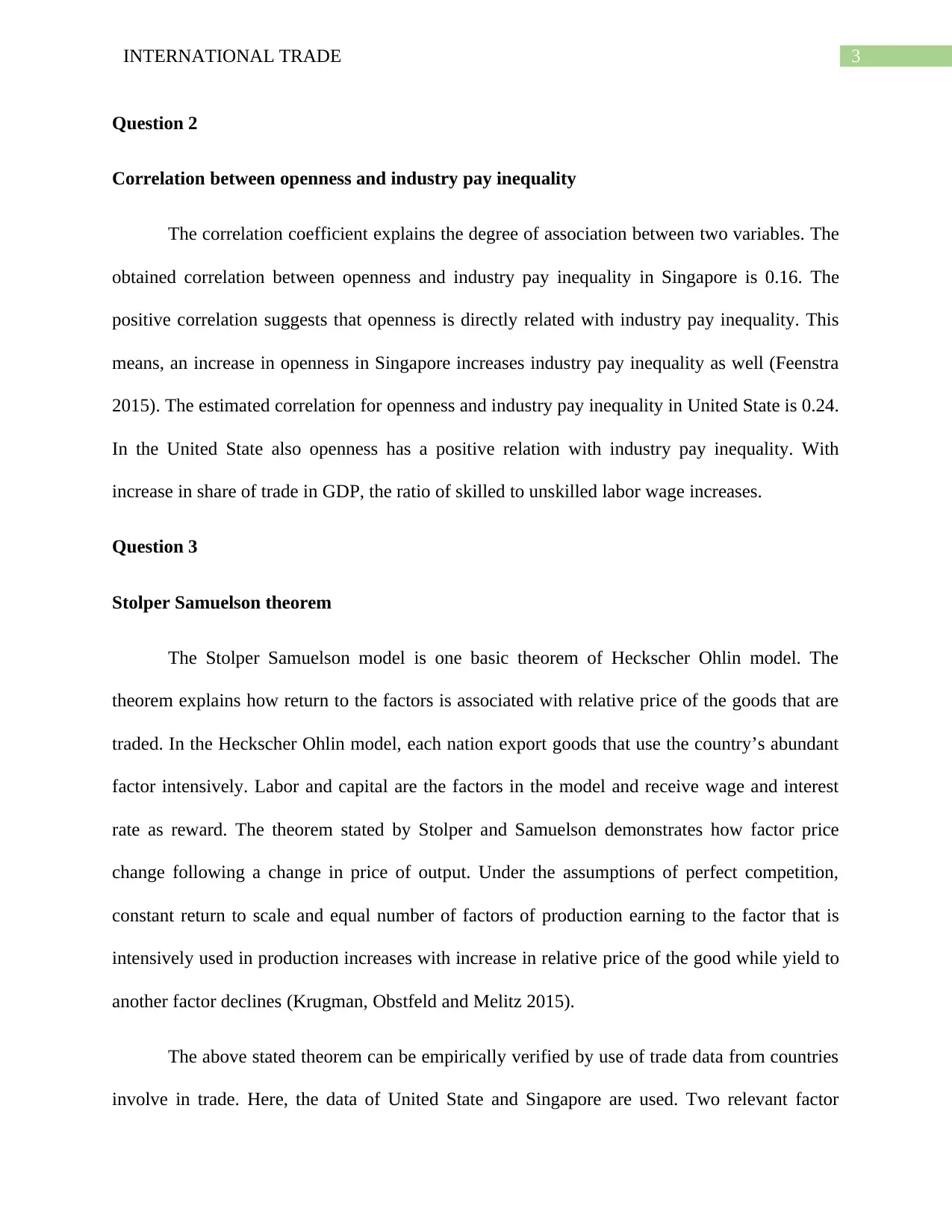
3INTERNATIONAL TRADE
Question 2
Correlation between openness and industry pay inequality
The correlation coefficient explains the degree of association between two variables. The
obtained correlation between openness and industry pay inequality in Singapore is 0.16. The
positive correlation suggests that openness is directly related with industry pay inequality. This
means, an increase in openness in Singapore increases industry pay inequality as well (Feenstra
2015). The estimated correlation for openness and industry pay inequality in United State is 0.24.
In the United State also openness has a positive relation with industry pay inequality. With
increase in share of trade in GDP, the ratio of skilled to unskilled labor wage increases.
Question 3
Stolper Samuelson theorem
The Stolper Samuelson model is one basic theorem of Heckscher Ohlin model. The
theorem explains how return to the factors is associated with relative price of the goods that are
traded. In the Heckscher Ohlin model, each nation export goods that use the country’s abundant
factor intensively. Labor and capital are the factors in the model and receive wage and interest
rate as reward. The theorem stated by Stolper and Samuelson demonstrates how factor price
change following a change in price of output. Under the assumptions of perfect competition,
constant return to scale and equal number of factors of production earning to the factor that is
intensively used in production increases with increase in relative price of the good while yield to
another factor declines (Krugman, Obstfeld and Melitz 2015).
The above stated theorem can be empirically verified by use of trade data from countries
involve in trade. Here, the data of United State and Singapore are used. Two relevant factor
Question 2
Correlation between openness and industry pay inequality
The correlation coefficient explains the degree of association between two variables. The
obtained correlation between openness and industry pay inequality in Singapore is 0.16. The
positive correlation suggests that openness is directly related with industry pay inequality. This
means, an increase in openness in Singapore increases industry pay inequality as well (Feenstra
2015). The estimated correlation for openness and industry pay inequality in United State is 0.24.
In the United State also openness has a positive relation with industry pay inequality. With
increase in share of trade in GDP, the ratio of skilled to unskilled labor wage increases.
Question 3
Stolper Samuelson theorem
The Stolper Samuelson model is one basic theorem of Heckscher Ohlin model. The
theorem explains how return to the factors is associated with relative price of the goods that are
traded. In the Heckscher Ohlin model, each nation export goods that use the country’s abundant
factor intensively. Labor and capital are the factors in the model and receive wage and interest
rate as reward. The theorem stated by Stolper and Samuelson demonstrates how factor price
change following a change in price of output. Under the assumptions of perfect competition,
constant return to scale and equal number of factors of production earning to the factor that is
intensively used in production increases with increase in relative price of the good while yield to
another factor declines (Krugman, Obstfeld and Melitz 2015).
The above stated theorem can be empirically verified by use of trade data from countries
involve in trade. Here, the data of United State and Singapore are used. Two relevant factor
Paraphrase This Document
Need a fresh take? Get an instant paraphrase of this document with our AI Paraphraser
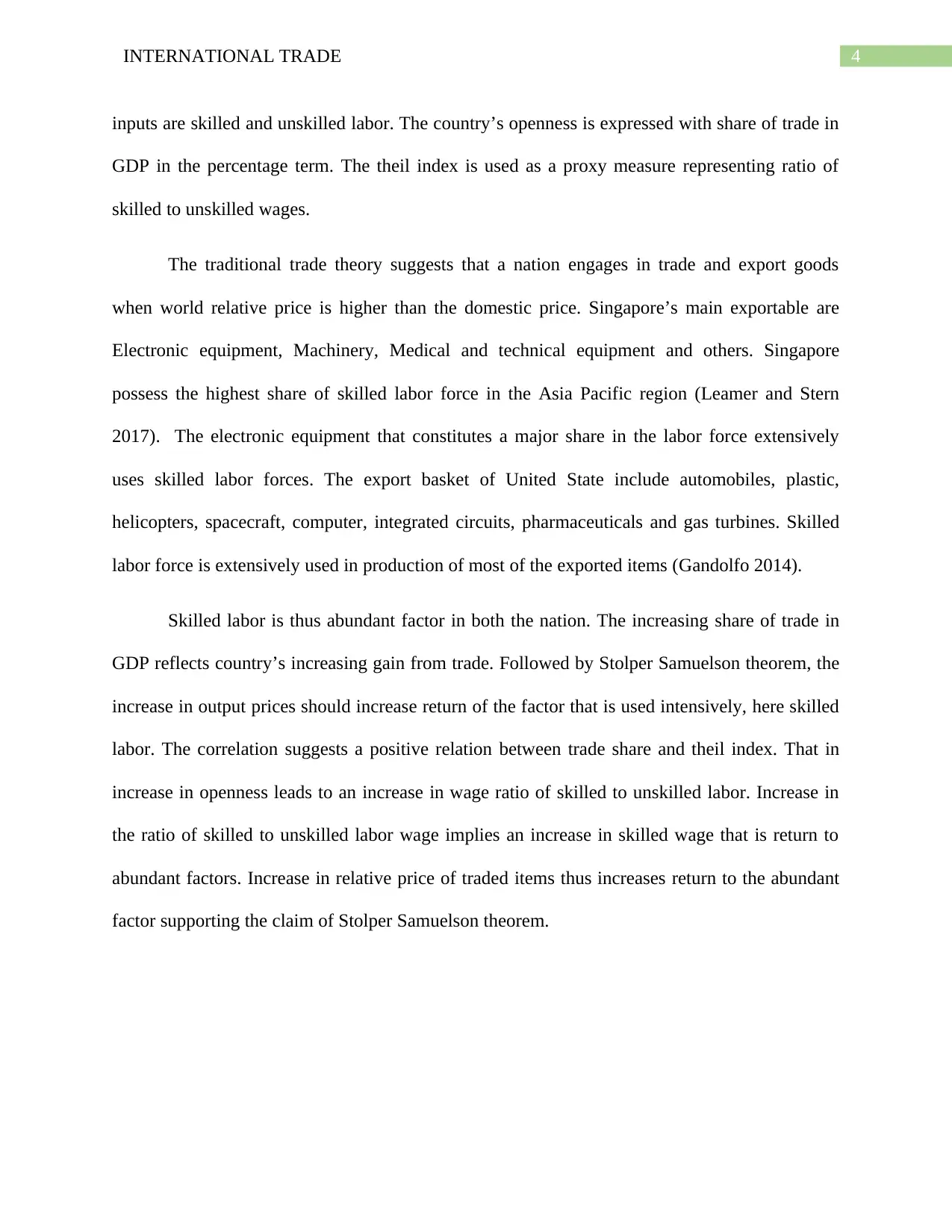
4INTERNATIONAL TRADE
inputs are skilled and unskilled labor. The country’s openness is expressed with share of trade in
GDP in the percentage term. The theil index is used as a proxy measure representing ratio of
skilled to unskilled wages.
The traditional trade theory suggests that a nation engages in trade and export goods
when world relative price is higher than the domestic price. Singapore’s main exportable are
Electronic equipment, Machinery, Medical and technical equipment and others. Singapore
possess the highest share of skilled labor force in the Asia Pacific region (Leamer and Stern
2017). The electronic equipment that constitutes a major share in the labor force extensively
uses skilled labor forces. The export basket of United State include automobiles, plastic,
helicopters, spacecraft, computer, integrated circuits, pharmaceuticals and gas turbines. Skilled
labor force is extensively used in production of most of the exported items (Gandolfo 2014).
Skilled labor is thus abundant factor in both the nation. The increasing share of trade in
GDP reflects country’s increasing gain from trade. Followed by Stolper Samuelson theorem, the
increase in output prices should increase return of the factor that is used intensively, here skilled
labor. The correlation suggests a positive relation between trade share and theil index. That in
increase in openness leads to an increase in wage ratio of skilled to unskilled labor. Increase in
the ratio of skilled to unskilled labor wage implies an increase in skilled wage that is return to
abundant factors. Increase in relative price of traded items thus increases return to the abundant
factor supporting the claim of Stolper Samuelson theorem.
inputs are skilled and unskilled labor. The country’s openness is expressed with share of trade in
GDP in the percentage term. The theil index is used as a proxy measure representing ratio of
skilled to unskilled wages.
The traditional trade theory suggests that a nation engages in trade and export goods
when world relative price is higher than the domestic price. Singapore’s main exportable are
Electronic equipment, Machinery, Medical and technical equipment and others. Singapore
possess the highest share of skilled labor force in the Asia Pacific region (Leamer and Stern
2017). The electronic equipment that constitutes a major share in the labor force extensively
uses skilled labor forces. The export basket of United State include automobiles, plastic,
helicopters, spacecraft, computer, integrated circuits, pharmaceuticals and gas turbines. Skilled
labor force is extensively used in production of most of the exported items (Gandolfo 2014).
Skilled labor is thus abundant factor in both the nation. The increasing share of trade in
GDP reflects country’s increasing gain from trade. Followed by Stolper Samuelson theorem, the
increase in output prices should increase return of the factor that is used intensively, here skilled
labor. The correlation suggests a positive relation between trade share and theil index. That in
increase in openness leads to an increase in wage ratio of skilled to unskilled labor. Increase in
the ratio of skilled to unskilled labor wage implies an increase in skilled wage that is return to
abundant factors. Increase in relative price of traded items thus increases return to the abundant
factor supporting the claim of Stolper Samuelson theorem.
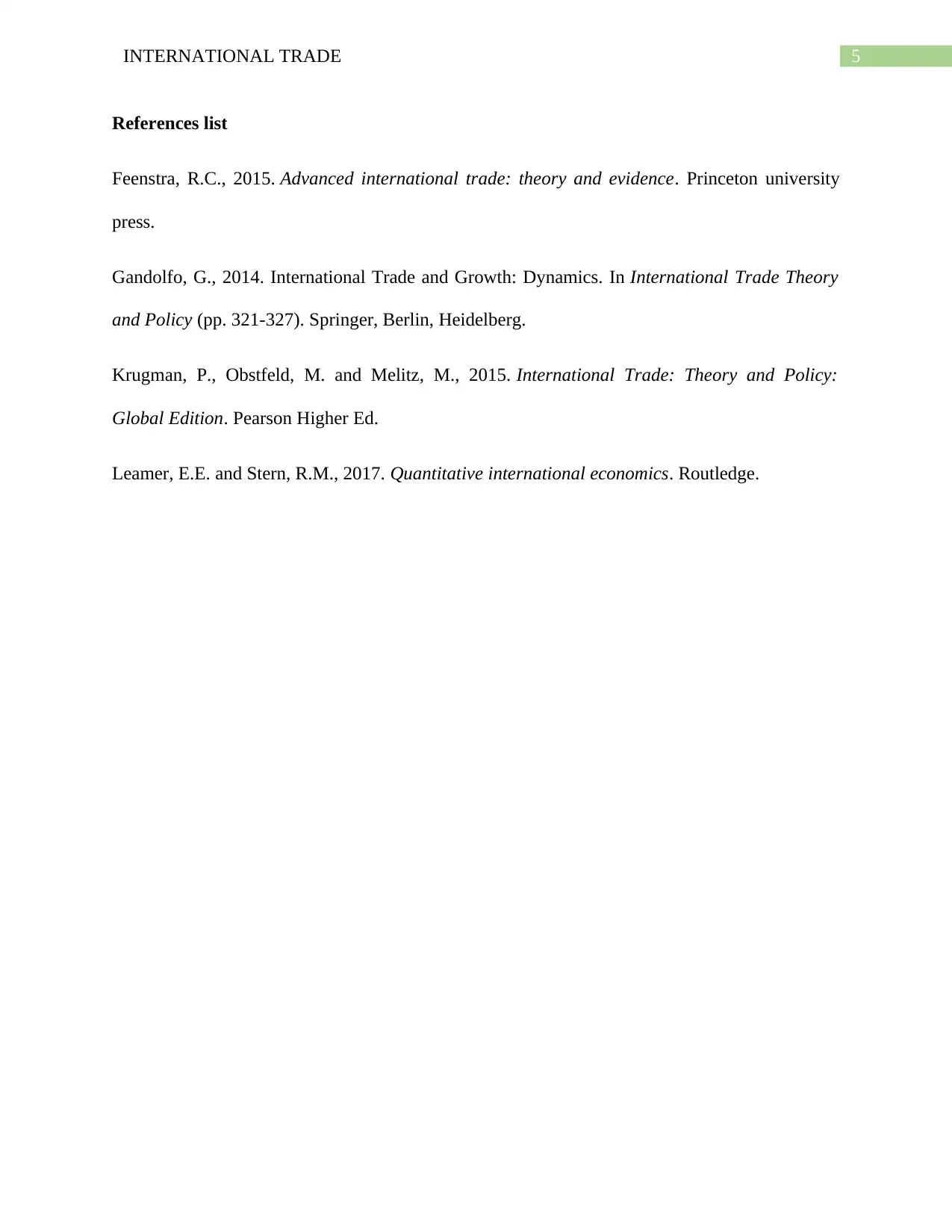
5INTERNATIONAL TRADE
References list
Feenstra, R.C., 2015. Advanced international trade: theory and evidence. Princeton university
press.
Gandolfo, G., 2014. International Trade and Growth: Dynamics. In International Trade Theory
and Policy (pp. 321-327). Springer, Berlin, Heidelberg.
Krugman, P., Obstfeld, M. and Melitz, M., 2015. International Trade: Theory and Policy:
Global Edition. Pearson Higher Ed.
Leamer, E.E. and Stern, R.M., 2017. Quantitative international economics. Routledge.
References list
Feenstra, R.C., 2015. Advanced international trade: theory and evidence. Princeton university
press.
Gandolfo, G., 2014. International Trade and Growth: Dynamics. In International Trade Theory
and Policy (pp. 321-327). Springer, Berlin, Heidelberg.
Krugman, P., Obstfeld, M. and Melitz, M., 2015. International Trade: Theory and Policy:
Global Edition. Pearson Higher Ed.
Leamer, E.E. and Stern, R.M., 2017. Quantitative international economics. Routledge.
⊘ This is a preview!⊘
Do you want full access?
Subscribe today to unlock all pages.

Trusted by 1+ million students worldwide
1 out of 6
Related Documents
Your All-in-One AI-Powered Toolkit for Academic Success.
+13062052269
info@desklib.com
Available 24*7 on WhatsApp / Email
![[object Object]](/_next/static/media/star-bottom.7253800d.svg)
Unlock your academic potential
Copyright © 2020–2025 A2Z Services. All Rights Reserved. Developed and managed by ZUCOL.





